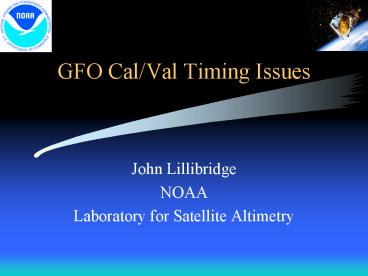GFO CalVal Timing Issues PowerPoint PPT Presentation
Title: GFO CalVal Timing Issues
1
GFO Cal/Val Timing Issues
- John Lillibridge
- NOAA
- Laboratory for Satellite Altimetry
2
Overview of Mission Status
- Launch on February 10, 1998
- CPU resets fixed in Rev. E software November,
1999 - GPS system failure
- Utilize operational Doppler and precision laser
orbits - Time tagging via ground-segment hardware June,
1999
3
CPU Resets Data availability
4
Precision Timing Issues
- Time-tag stability uniformity
- Spacing between records 0.98 s
- Ultra-Stable-Oscillator clock drift
- Changes in clock frequency alter range
travel-time counts - Timing biases between Range Orbit
- msec level timing biases yield cm level errors at
twice-per-rev
5
GFO Timing Stability
6
Geosat Timing Stability
7
Example of non-uniform spacing
8
Summary of Timing Stability
- GFO time-tagging is noisy at the 10 µsec level,
compared to 1 µsec for Geosat (implies height
error at the 0.1 mm level) - GFO exhibits 10 Hz frame slips, but this only
occurs in 0.1 of the data - The uneven spacing of GFOs records does NOT
imply an error in time-tagging
9
USO Height Correction - GFO
10
USO Height Correction - Geosat
11
Summary of Clock Drift
- GFOs Doppler beacon oscillator is drifting at a
rate 10x worse than Geosat - The USO height correction is large, but is
implicitly corrected during SDR production - The estimation of the USO height correction can
suffer from large bookkeeping errors
12
Timing Biases - Laser Orbits
13
Height Variability - with orbit error
14
Height Variability - no orbit error
15
Summary of Timing Biases
- Before installation of the time-tagging unit
timing biases were on the order of seconds - Timing biases of 1 1 msec are seen after
time-tagging unit installed - acceptable - Removal of one and two cycle-per-rev orbit error
yields expected sea level variability
16
NGDR Issues
- Byte-alignment problem in last 5 data fields
- Currently no slot allocated for model wet
troposphere correction - Cases of flagged sigma-H with good SSH
- 10 Hz heights not analyzed sufficiently yet
- Need to determine optimal SSB correction
PowerShow.com is a leading presentation sharing website. It has millions of presentations already uploaded and available with 1,000s more being uploaded by its users every day. Whatever your area of interest, here you’ll be able to find and view presentations you’ll love and possibly download. And, best of all, it is completely free and easy to use.
You might even have a presentation you’d like to share with others. If so, just upload it to PowerShow.com. We’ll convert it to an HTML5 slideshow that includes all the media types you’ve already added: audio, video, music, pictures, animations and transition effects. Then you can share it with your target audience as well as PowerShow.com’s millions of monthly visitors. And, again, it’s all free.
About the Developers
PowerShow.com is brought to you by CrystalGraphics, the award-winning developer and market-leading publisher of rich-media enhancement products for presentations. Our product offerings include millions of PowerPoint templates, diagrams, animated 3D characters and more.

